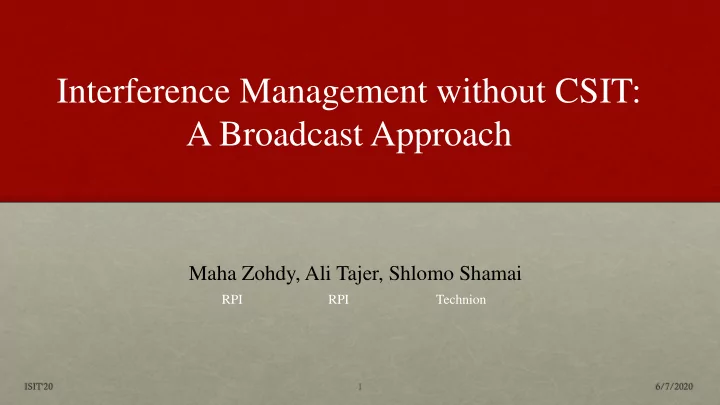

Interference Management without CSIT: A Broadcast Approach Maha Zohdy, Ali Tajer, Shlomo Shamai RPI RPI Technion ISIT'20 1 6/7/2020
Interference Channel • Interference Avoidance Interference management • Interference Cancellation under lack of CSIT • Interference Coordination 6/7/2020 ISIT'20 2
Related Literature Full CSIT • Best inner bound on IC capacity with full CSIT (Han & Kobayashi’81) • HK scheme achieves capacity within 1- bit (Etkin, David, & Wang’08) No CSIT in high SNR regime • Blind interference alignment (Jafar’ 12) • Impact of topology on blind IA (Naderializadeh & Avestimehr,’14) • Binary ergodic IC (Maddah- Ali, Avestimehr, & Zhu’17) No CSIT in non-asymptotic regime • Erasure IC (Zhu & Shen’16) • Degraded IC (Raja, Prabhakaran, & Viswanath’09) • Approximate capacity for fast fading IC ( Sebastian, Karakus, & Diggavi’18 ) 6/7/2020 ISIT'20 3
CSIT Uncertainty Slowly fading channels • Receiver can acquire perfect CSI • Dynamic CSIT modeling: fixed + variable • No delay constraint: ergodic approach • Stringent delay constraint: Outage approach Broadcast approach • No CSI at Tx • No CSI at Tx • Fixed rate • Rate adapted to actual channel • Failure when channel not strong enough • Partial success even for weak channels 6/7/2020 ISIT'20 4
Related Literature Broadcast approach • Proposed for compound channels (Cover’72) • Proposed for single- user Gaussian channel (Shamai’97) • Used in successive refinement of source coding (Remoldy’09) • Generalized to multi- antenna systems (Shamai & Stiener’03) 6/7/2020 ISIT'20 5
Broadcast Approach to SU Channel Single-user channel with ℓ − states unknown to Tx 6/7/2020 ISIT'20 6
Broadcast Approach to SU Channel Single-user channel with ℓ − states Successive decoding Codebook assignment 6/7/2020 ISIT'20 7
Channel Model Two-user IC with no CSIT • Each receiver is affected by both transmissions • Each transmitter is affected by combined network state • No CSIT at Tx; adapt broadcast approach to combined network state 6/7/2020 ISIT'20 8
Channel Model Two-user IC with two-state channel Channel input-output relationship: Unknown to Tx 1 Unknown to Tx 2 Known to Rx 2-channel states: 6/7/2020 ISIT'20 9
Normalized Channel Model Normalized two-user IC with two-state channel Channel input-output relationship: Unknown to Tx 1 Unknown to Tx 2 Known to Rx 3-channel states: 6/7/2020 ISIT'20 10
Adapting to Multiuser Channel Adapt to multi-user channel No unique way to order channel states! 6/7/2020 ISIT'20 11
Codebook Assignment Normalized two-user channel with no CSIT 3-channel states: Codebook assignment User 1 User 2 6/7/2020 ISIT'20 12
Average Rate Region Asymmetric channel 6/7/2020 ISIT'20 13
Average Rate Region Asymmetric channel User 1 User 2 6/7/2020 ISIT'20 14
Gap to Sum-rate Capacity Symmetric channel: Use HK sum-rate under power allocation in Sum-rate capacity is known (Etkin, Tse , & Wang’08) Theorem 2. For large asymptote of 𝑄 and any fixed channel state, the average sum-rate achievable by the proposed scheme lies within a finite gap to the sum-rate capacity of symmetric IC with full CSIT. The gap is bounded as follows 6/7/2020 ISIT'20 15
Capacity Approximation Degrees of freedom (DoF) • First-order capacity approximation • Limit of ratio of sum-capacity to logarithm of SNR • DoF not lost without CSIT (1 for two-user IC) Theorem 2. For large asymptote of 𝑄 any fixed channel state, the average sum-rate achievable by the proposed scheme lies within a finite gap to the sum-rate capacity of symmetric IC with full CSIT. The gap is bounded as follows 6/7/2020 ISIT'20 16
Average Sum-rate Gap Normalized gap Bound on gap Symmetric channel 6/7/2020 ISIT'20 17
Main Observations Broadcast approach to two-user IC with no CSIT • Proposed novel BC scheme adapted to combined network state. • Characterized the resulting average achievable rate region. • Characterized gap to sum-rate capacity in the asymptote of high SNR. Possible extensions • Adapt BC approach to IC with local CSIT . • Identify most valuable subset of local CSIT. 6/7/2020 ISIT'20 18
Thank you! 6/7/2020 ISIT'20 19
References • T. Han and K. Kobayashi, “A new achievable rate region for the interference channel,” IEEE Transactions on Information Theory , vol. 27, no. 1, pp. 49 – 60, Jan. 1981. • R. H. Etkin , N. David, and H. Wang, “Gaussian interference channel capacity to within one bit,” IEEE Transactions on Information Theory , vol. 54, no. 12, pp. 5534 – 5562, Nov. 2008. • V. R. Cadambe and S. A. Jafar, “Interference alignment and degrees of freedom of the K - user interference channel,” IEEE Transactions on Information Theory , vol. 54, no. 8, pp. 3425 – 3441, Jul. 2008. • T. Cover, “Broadcast channels,” IEEE Transactions on Information Theory , vol. 18, no. 1, pp. 2 – 14, Jan. 1972. • S. Shamai (Shitz), “A broadcast strategy for the Gaussian slowly fading channel,” in Proc. IEEE International Symposium Information Theory , Ulm, Germany, Jun. 1997, p. 150. • S. Shamai (Shitz) and A. Steiner, “A broadcast approach for a single user slowly fading MIMO channel,” IEEE Transactions on Information Theory , vol. 49, no. 10, pp. 2617 – 2635, Oct. 2003. • S. Kazemi and A. Tajer, “Multiaccess communication via a broadcast approach adapted to the multiuser channel,” IEEE Transactions on Communications , vol. 66, no. 8, pp. 3341 – 3353, Feb. 2018. • M. Zohdy, A. Tajer, and S. Shamai (Shitz), “Broadcast approach to multiple access with local CSIT,” IEEE Transactions on Communications , vol. 67, no. 11, pp. 7483 – 7498, Aug. 2019. 20
Recommend
More recommend